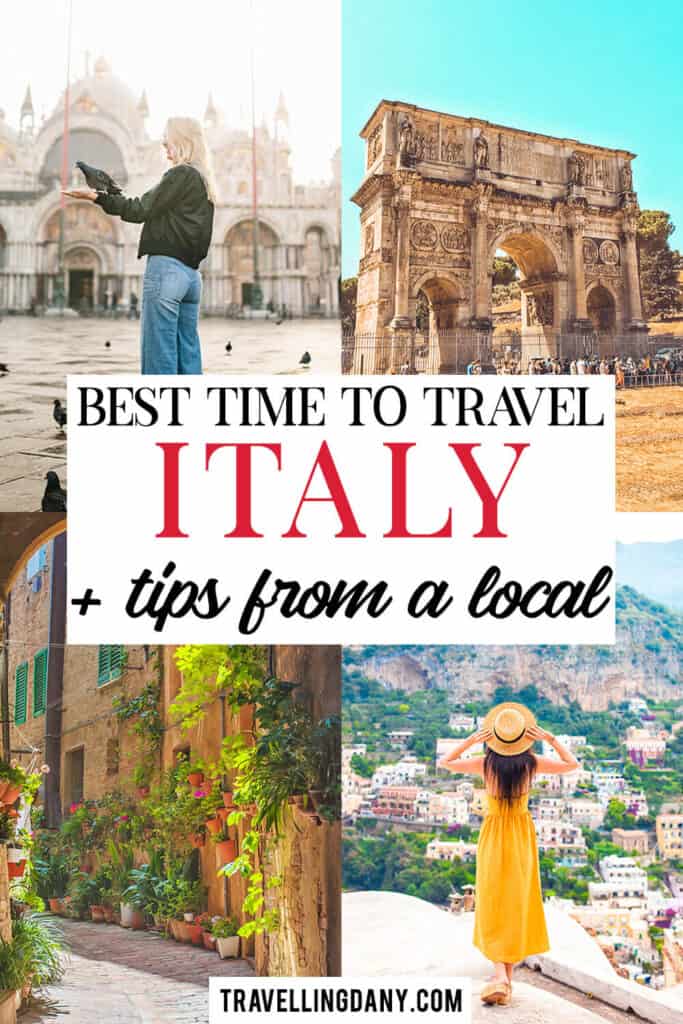The best time to visit Italy in 2024 according to a local!
This post includes affiliate links. As an Amazon Associate, I earn from qualifying purchases. Full disclosure.
Italy is one of the most popular travel destinations in the world, known for its rich history, beautiful landscapes, delicious food, and stunning architecture. There is something for everyone! But when is the best time to visit Italy? As a local, I think I can help!
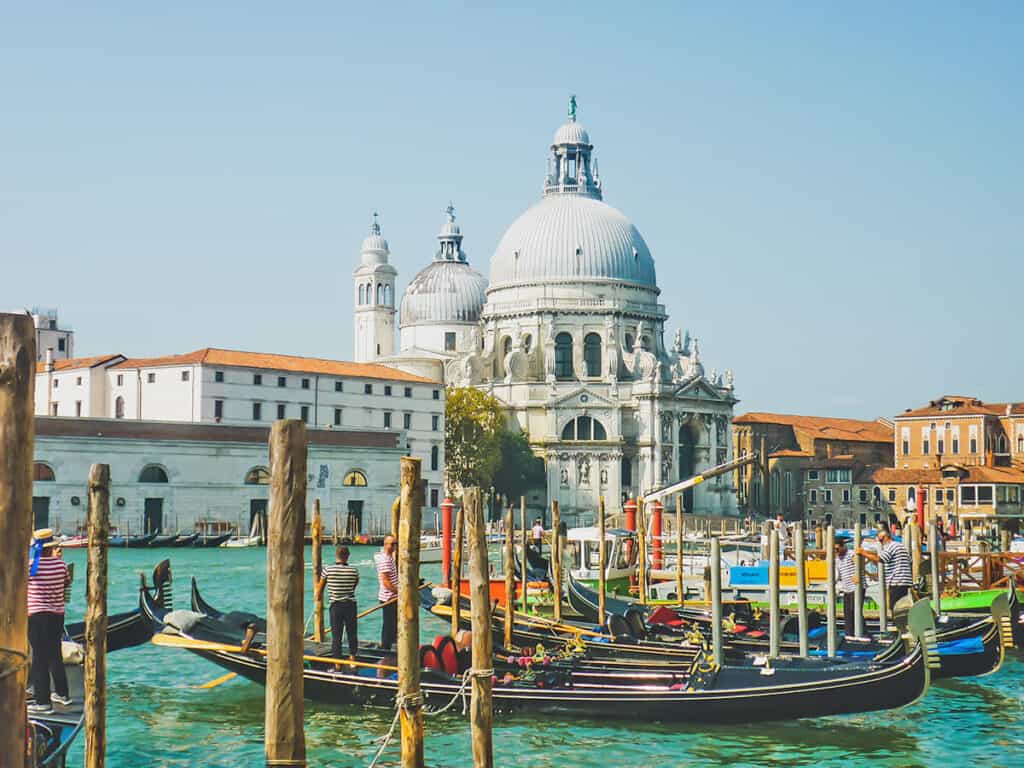
Are you planning your dream trip but you’re still wondering when is the best time to go to Italy? It’s understandable and you’re not alone! Italy is a beautiful destination that has something to offer for everyone. Yet it can be expensive and that’s why you have to be strategic while planning this trip. Let me offer a few useful pointers that can make the difference!
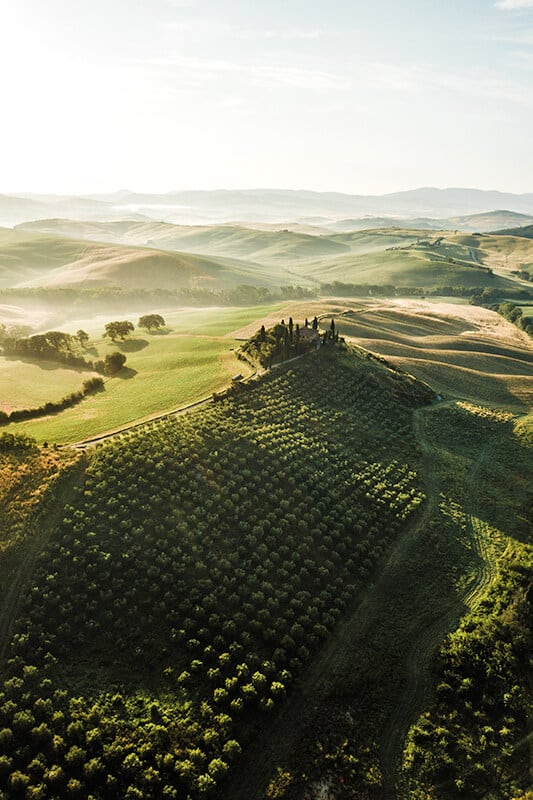
Quick Links to Post Content
Deciding when it’s the perfect time to visit
From the rolling hills of Tuscany to the rugged coastlines of the Amalfi Coast, Italy’s landscapes are some of the most stunning in the world.
Yet, whether you enjoy hiking, swimming, or simply taking in the scenery, you need pleasant weather and possibly also fewer tourists.
That would make your trip unforgettable.
My Country is home to many iconic landmarks that are recognized around the world, including the Colosseum, the Leaning Tower of Pisa, and Vatican City.
They all have something in common: you need to avoid the crowds.
Which might be tricky.
Are you aware of the
New Europe Visa Requirements in 2024?
As you might know already, Italians are known for being super welcoming to visitors.
Whether you’re asking for directions or ordering a meal, we are usually happy to help and will make you feel at home.
Even when we do not speak English!
Many Italians take a trip in summertime.
Yes, we are welcoming, but we can also be loud. And if you go to a travel destination on the busiest time of the year, prices will go up.
The time of the year you choose is thus super important.
It also depends mostly on your Italy itinerary.
Let me show you why!
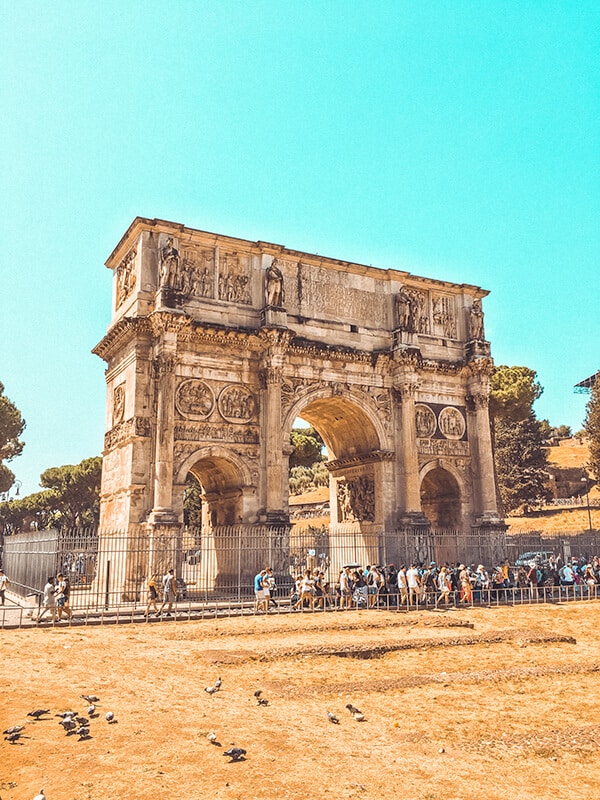
When is the best time to visit Italy?
Italy is a beautiful country.
Yes, I’m absolutely biased, because I’m Italian!
The truth is that you can plan this trip all year round.
I do not think there is a bad time to visit.
It all depends on your interests and preferences.
Generally speaking, the shoulder season is a great time to visit.
So plan your trip from April to early June or in September and October.
The weather is mild, there are fewer crowds, and prices are lower.
There’s no reason to think that things in Italy in 2024 will change.
Yet I would like to offer a bit of food for thought that could help you plan the perfect trip.
As a local I hope the following chapters can be useful!
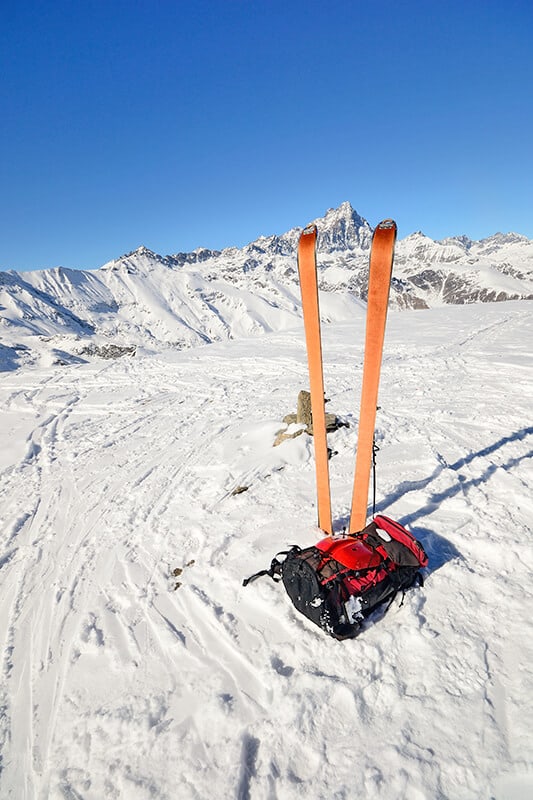
My weather considerations: winter months or summer months?
Italy has a Mediterranean climate, which means mild winters and hot summers.
However, the weather can vary significantly depending on the region.
There are differences between north and south!
If you prefer mild weather, as I already mentioned in the previous chapter, you shoud opt for the shoulder season.
So April to June or from September to October.
July and August are absolutely hot.
Especially in Southern Italy.
Add to that the fact that Italians choose to plan their vacations on these two months.
August, especially.
Much of Italy will be super crowded, expensive and overall less than pleasant.
In the northern regions, the climate is continental, with cold winters and hot summers.
If you’re thinking of planning a quiet trip to Positano, this might not be the right time to do that.
In Lombardy, Piedmont, and Veneto for example, winter comes with heavy snowfall.
The summer months are hot and humid.
Northern Italy in autumn also tends to be wetter than the south.
Something to keep in mind if you have a specifical open-air attraction you want to go to!
Here in the South we have mild winters (snow is a rare occurrence) but super hot summers.
Campania, Calabria and Sicily have the best weather if you choose to visit our beaches.
Yet July and August are considered peak season in Italy!
Check out next chapter for my considerations about that.
Spring in Southern Italy is going to be the best time to travel.
Beaches are less crowded, it’s not going to be too hot but you can still get a lovely tan.
Try the Amalfi Coast beaches or Sicily!
One last consideration is that even within each region there can be different weather conditions.
For example coastal areas tend to be warmer and wetter. While the mountains like Alps or Dolomites in winter get a lot of snow.
Tip: always check the weather forecast before you start packing for Italy!
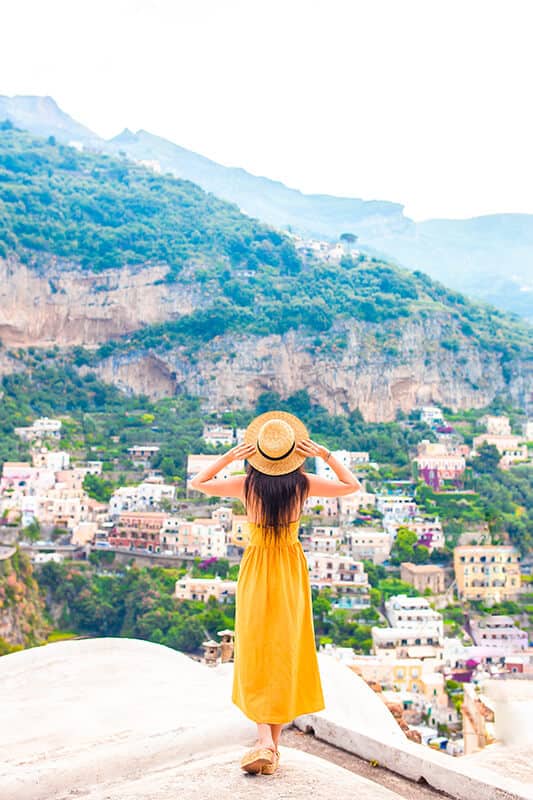
Crowds and prices: how to choose the cheapest time to go
Crowds and prices in Italy can vary significantly throughout the year.
Our peak tourist season goes from mid-June to August.
The weather is warm and sunny, and many people take their summer vacations.
Including us locals!
During this time, popular tourist destinations such as Rome, Florence, and Venice can be very crowded.
Prices for accommodations, restaurants, and activities can be higher than at other times of the year.
Speaking from experience I can tell you that in places like Rome and Florence even just walking around gets difficult.
It’s a busy time of the year, that can also be expensive.
Not the best if you’re planning your Italian honeymoon!
In the month of August, temperatures here in the south soar.
Making regions like Campania, Puglia, Sicilia or Calabria popular destinations for sun-seekers.
April to May an September to October are good months if you want to visit Italy on a budget.
The weather is pleasant at this time and prices are more reasonable.
Make sure you avoid the Easter crowds in April, by planning this trip around the holiday!
Low season in Italy goes from November to March. The tourist crowds are at their lowest and you can find budget accomodations throughout Italy.
You might also like:
Where to go in Italy in winter
However it’s important to note two facts.
In winter some attractions and restaurants may have reduced hours or be closed entirely.
February and March also mean Valentine’s day and Carnival.
Many people plan romantic Italian getaways. And Venice Carnival makes the whole region super crowded and expensive.
Overall, if you want to avoid crowds and save money, it’s a good idea to visit Italy during the shoulder or low seasons.
If you prefer warmer weather and don’t mind the crowds, the summer months can be a great time to plan this trip.
Yet you should expect to pay more for accommodations and activities.
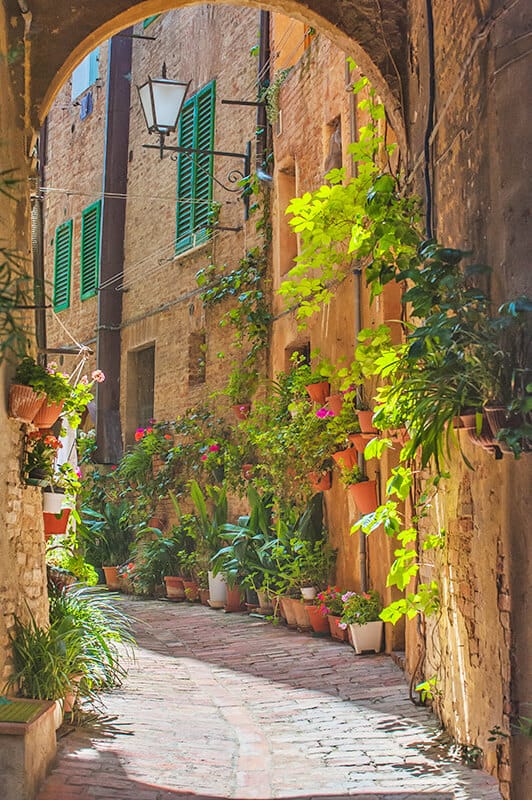
Shoulder seasons: know the best time to go!
The “shoulder seasons” to travel to Italy are typically the months of April to the beginning of the month of June. And late September to early November.
Overall, visiting Italy during the shoulder seasons can be a great way to experience the country with fewer crowds and at a lower cost.
However, it’s important to consider the potential challenges and plan accordingly.
Let’s see in detail the pros and cons of choosing this time of year to travel to Italy.

Pros – Why it’s a fantastic time
1. Smaller crowds: During the shoulder seasons, the number of tourists in Italy is typically lower, so you can expect shorter lines at museums and galleries. The major cities like Florence and Rome should be much more approachable.
2. Mild Weather: The shoulder seasons are characterized by pleasant weather with cooler temperatures than in the peak summer months. This can make it more comfortable to explore and participate in outdoor activities.
3. Lower costs: Airfares, accommodation, and other travel-related expenses are often lower during the shoulder seasons, compared to any other busy time of year.
4. Authentic experience: With fewer tourists around, you may have more opportunities to interact with locals and experience the authentic Italian culture.
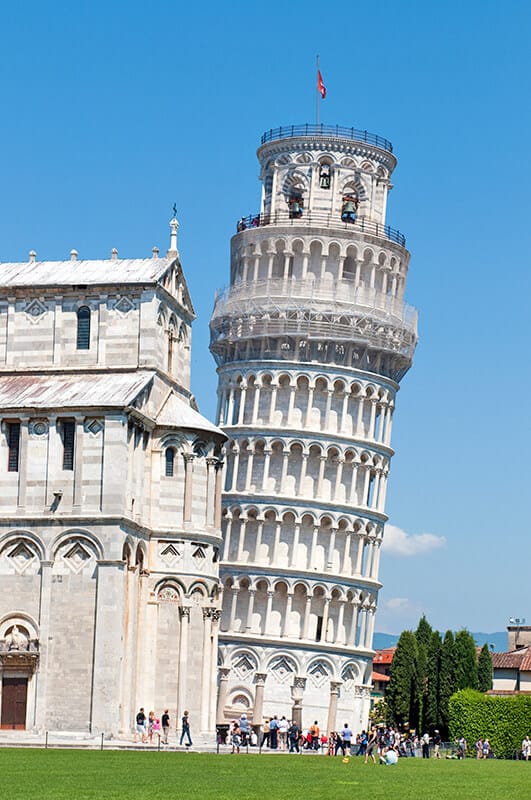
Cons – Things you should keep in mind
1. Unpredictable weather: While the weather during the shoulder seasons is generally mild, it can also be unpredictable. It’s best to pack for different types of weather and be prepared for sudden changes.
2. Limited operating hours: Some tourist attractions, restaurants, and shops may have limited operating hours during the shoulder seasons. This happens especially here in Southern Italy. So it’s important to check in advance if you have planned trips to the Amalfi Coast, our islands like Capri and Procida. Or even the small villages at Cinque Terre.
3. Limited activities: Some outdoor activities and beach destinations may not be available during the shoulder seasons due to cooler weather. If you’re planning a ski trip, this might not be the best time of year for this kind of vacation.
4. Reduced transportation options: In some areas of Italy, transportation options may be reduced during the shoulder seasons. Which can make it a bit more difficult to get around.
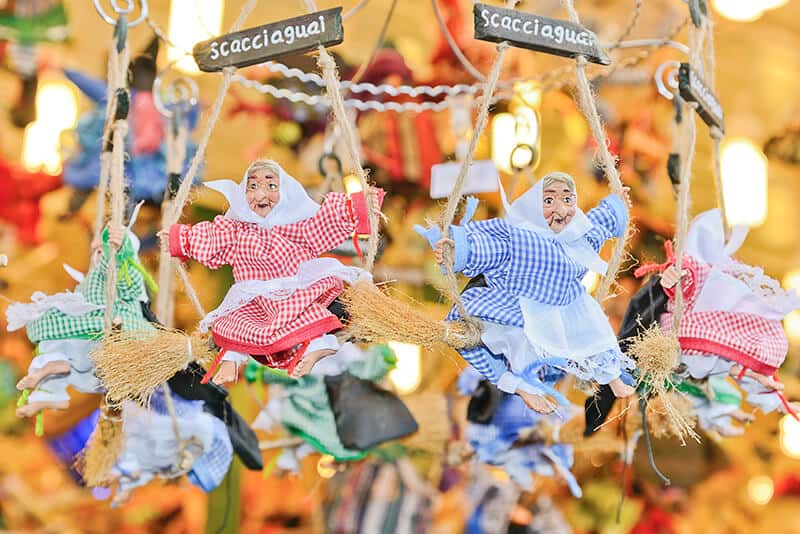
Holidays and Special Events in Italy
Many businesses and attractions may be closed or have reduced hours on national holidays and during some special events, so it’s a good idea to plan ahead if you want to participate in or attend any of these events.
Let me tell you all about the holidays you should be aware of!
Popular Festivals and Celebrations to Attend
Here are all the most important holidays in Italy you should mark on your calendar.
1. Capodanno – New Year’s Day (January 1st): Celebrated throughout Italy with fireworks, parades, and special events. This can be an expensive time to visit.
2. Epifania “La Befana” – Epiphany (January 6th): A Christian holiday celebrated with parades, live nativity scenes, and the traditional Italian “Calza“. A stocking filled with sweets.
3. Carnevale – Carnival (February/March): A celebration that includes parades, masquerade balls, and colorful costumes. The most famous Carnevale celebration takes place in Venice.
4. Pasqua – Easter (March/April): A major Christian holiday celebrated in Italy with religious processions, masses, and feasts. It’s a fun time to visit Rome!
5. Giorno della Liberazione – Liberation Day (April 25th): A national holiday commemorating the end of the Italian Civil War.
6. Festa dei Lavoratori – Labor Day (May 1st): A national holiday celebrating workers’ rights with parades and demonstrations.
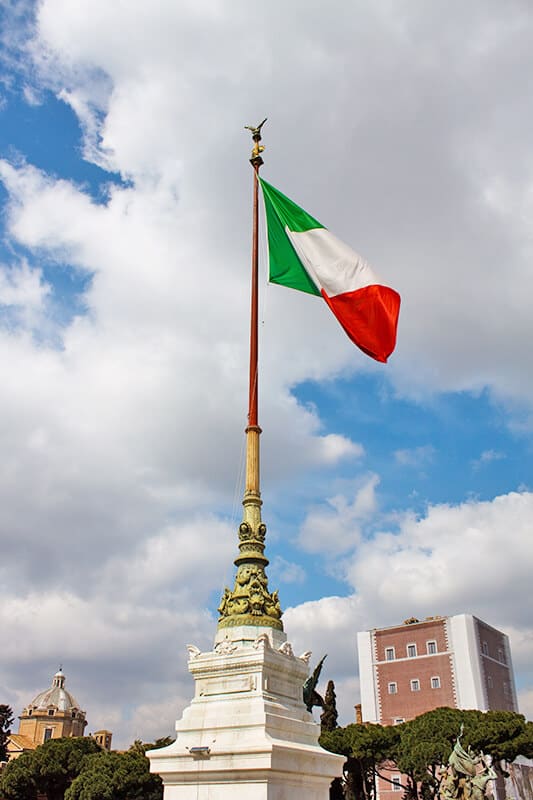
7. Festa della Repubblica – Republic Day (June 2nd): A national holiday celebrating the establishment of the Italian Republic in 1946.
8. Palio di Siena (July 2nd and August 16th): A horse race that takes place twice a year in Siena (Tuscany), with the city divided into 17 districts competing for the Palio, a banner made of silk. Plan to visit well in advance because the city is usually fully booked during Palio!
9. Ferragosto (August 15th): A national holiday celebrating the Assumption of Mary, with many Italians taking their annual summer vacation. Not the ideal time for a visit if you’re on a budget. Ferragosto is one of the most expensive time of year!
10. Ognissanti – All Saints’ Day (November 1st): A Christian holiday honoring the dead with visits to cemeteries, flowers, and candles.
11. Festa dell’Immacolata Concezione – Feast of the Immaculate Conception (December 8th): A Christian holiday celebrating the Virgin Mary’s conception without original sin, with many cities holding parades and lighting up their streets. This is also when many Christmas markets in Italy will open.
12. Natale – Christmas (December 25th): A Christian holiday celebrated with religious processions, Christmas markets, and feasts.
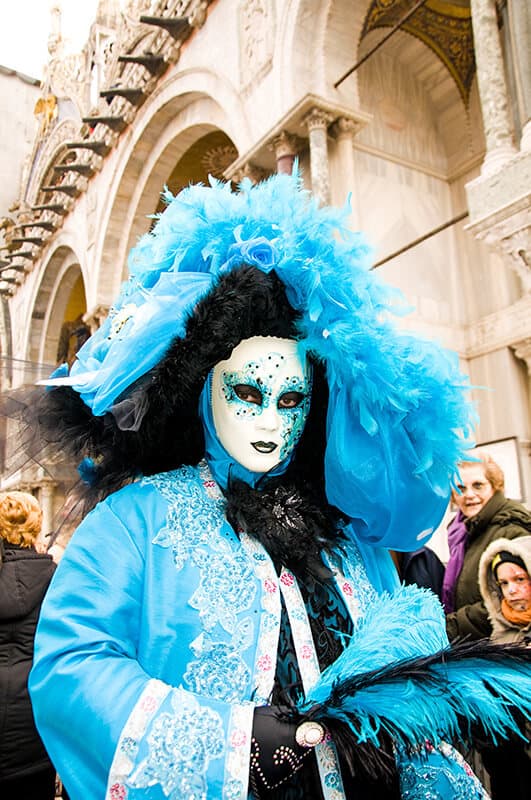
Popular events and festivals
Sadly for many of those there aren’t specific dates I can share with you all.
Every year the dates change a bit!
1. Carnevale di Venezia – Venice Carnival: This world-renowned festival takes place in February, with participants dressing up in elaborate masks and costumes and attending balls and other events.
2. Battaglia delle arance – Battle of the Oranges: Taking place during Carnevale in the town of Ivrea (Piedmont). Participants throw oranges at each other in a mock battle that commemorates a medieval uprising against a tyrant.
3. Infiorata: This flower festival takes place in the town of Spello (Umbria) in late May or early June. Artists create intricate carpets made of flower petals and other natural materials. It’s absolutely gorgeous!
Worried you’ll need a bit of help?
Download the FREE Italian Travel Phrasebook here! It includes the correct Italian pronunciation and lots of useful sentences that you’ll be able to use on your trip to Italy!
4. Palio di Siena: As mentioned earlier, this horse race takes place twice a year in Siena and is a huge event that draws visitors from all over the world.
5. Festa della Madonna Bruna: Held in the southern city of Matera (Basilicata) in July, this festival honors the patron saint of the city with a parade, fireworks, and other festivities.
6. Umbria Jazz Festival: An internationally acclaimed jazz festival that takes place in Perugia in July. There are performances by jazz legends and up-and-coming musicians.
7. L’Ardia di San Costantino: This horse race takes place in the town of Sedilo (Sardinia) in late July. Riders compete in a wild race around the town’s church.
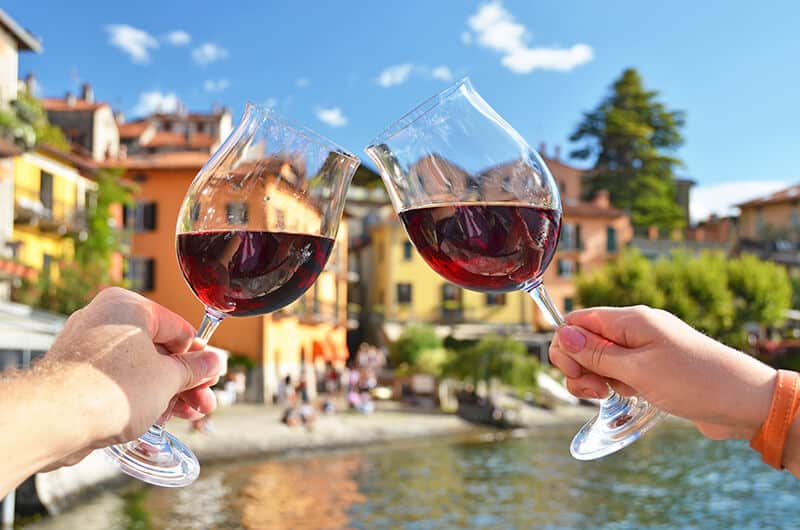
8. Festa della Vendemmia – Grape Harvest Festival: A celebration of the grape harvest that takes place in many wine-producing regions throughout Italy. Usually in September and October. There are events such as grape stomping, wine tastings, and parades. It’s a lot of fun!
9. Eurochocolate: Held in Perugia (Umbria) in October, this chocolate festival features tastings, cooking classes, and other chocolate-themed events. This is not the right time of year to visit Umbria if you want to see the authentic thing! The little towns are in fact usually overcrowded.
10. La Biennale di Venezia: This prestigious international art festival takes place in Venice (Veneto) every other year and features exhibitions by artists from around the world.
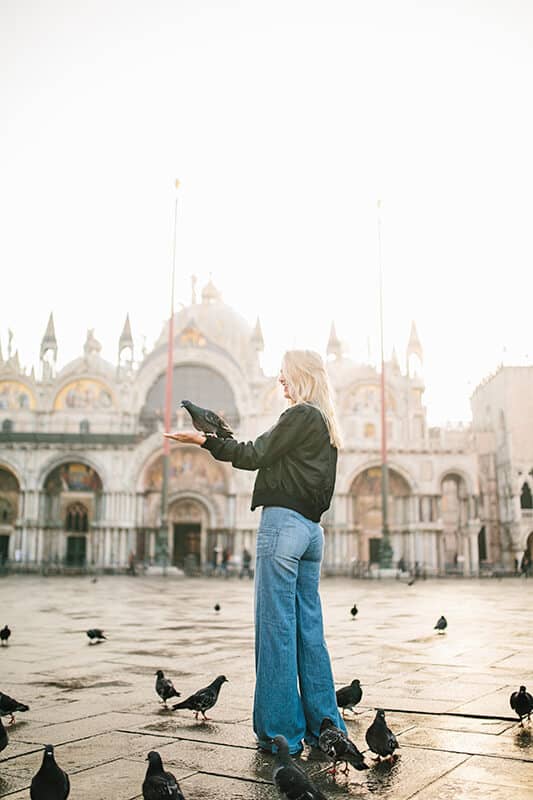
Tips for Planning and to avoid the crowds
The most important thing you can do, no matter the time of year you choose, is to plan ahead.
Many holidays and special events in Italy are popular and draw large crowds. It’s of vital importance to plan ahead.
Book your accommodations, transportation, and any tickets or reservations well in advance.
If you’re worried about changing your travel plans later on, make sure you choose tours offering free last minute cancellations.
Make sure to check for closures and reduced hours.
It’s not unusual that businesses and attractions will close or operate on reduced hours during special events.
Always check well in advance to adjust your itinerary accordingly.
No matter when you visit: some places will always be crowded.
Florence, I’m looking at you right now!
Be prepared for longer wait times and crowded streets.
Sometimes they are just unavoidable!
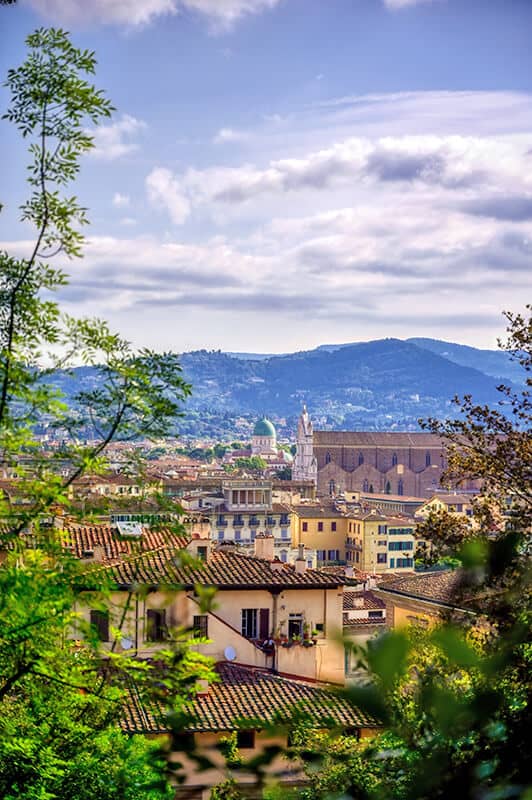
I’m sure you already thought of this and if you’re a seasoned traveler, it’s what you do wherever you go.
But please try to be respectful of our local customs!
Many holidays and special events here have a profound significance.
Make sure you pay attention and cover your shoulders and legs if you plan to attend religious ceremonies or processions.
Dressing appropriately is thus particularly important.
Not only when you visit religious buildings!
Carnevale di Venezia and Palio di Siena for example are known for their elaborate costumes and dress codes.
Check them out in advance so you can pack everything you need.
Last but not least, local events and holidays be a great opportunity to experience the authentic Italy you always dreamed of.
Sure, it’ll be crowded and maybe even more expensive.
Yet you’ll be introduced to Italian regional dishes, local traditions… and you can also meet new friends!
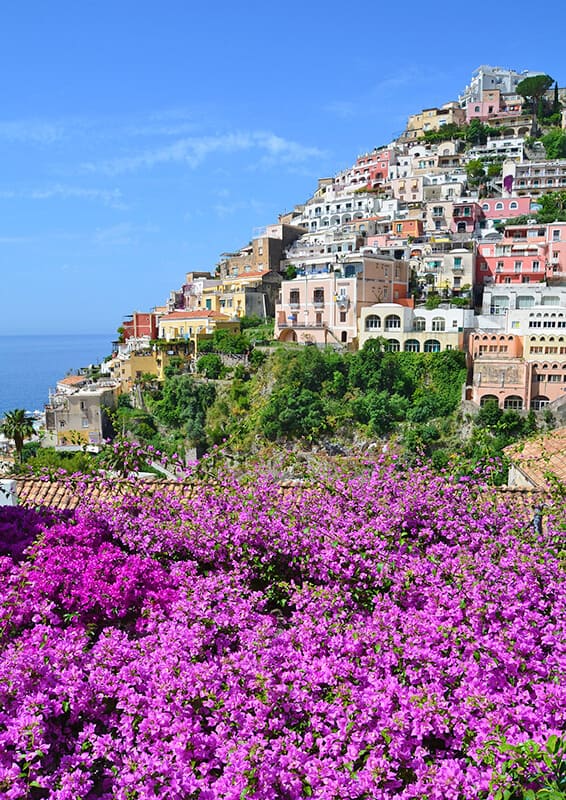
In a nutshell: is there a best time to travel to Italy?
The truth is that the best time to visit Italy depends on your personal preferences. And from your budget.
If you want to get a tan and you don’t mind crowds and expensive hotels, you should visit from mid-June to August.
On the contrary if you really want to experience the authentic Italy and you’re visiting on a budget, opt for the shoulder seasons.
Especially April and May or September to early November.
Have you already planned your next trip to Italy?
Let me know in the comments!
You might also like:
– A taste of Italy – The best regional food in Italy
– Italian Christmas food you should eat on your next trip to Italy
– 30 types of Italian Pizza you should absolutely eat
– 23 romantic Tuscany villages you’ll fall in love with
– Abruzzo Food Guide: How do the Abruzzese eat?
– 38 Authentic Italian Cocktails & Wines You Should Try
– Guide to ETIAS Authorisation and Schengen Visa Requirements
– Discover the best time to travel to Italy
– 37 Movies about Italy to watch before your trip
Pin it for later!
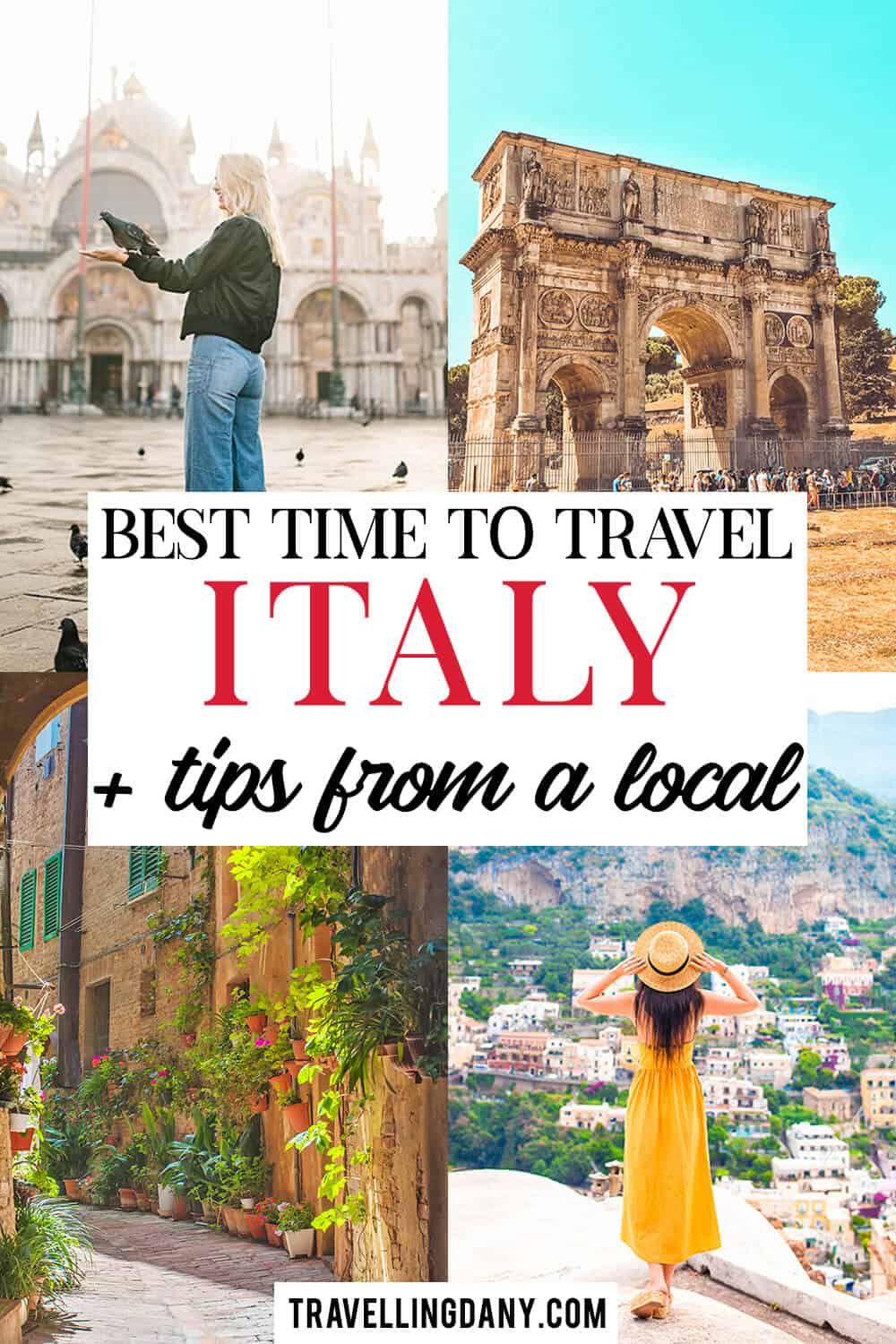
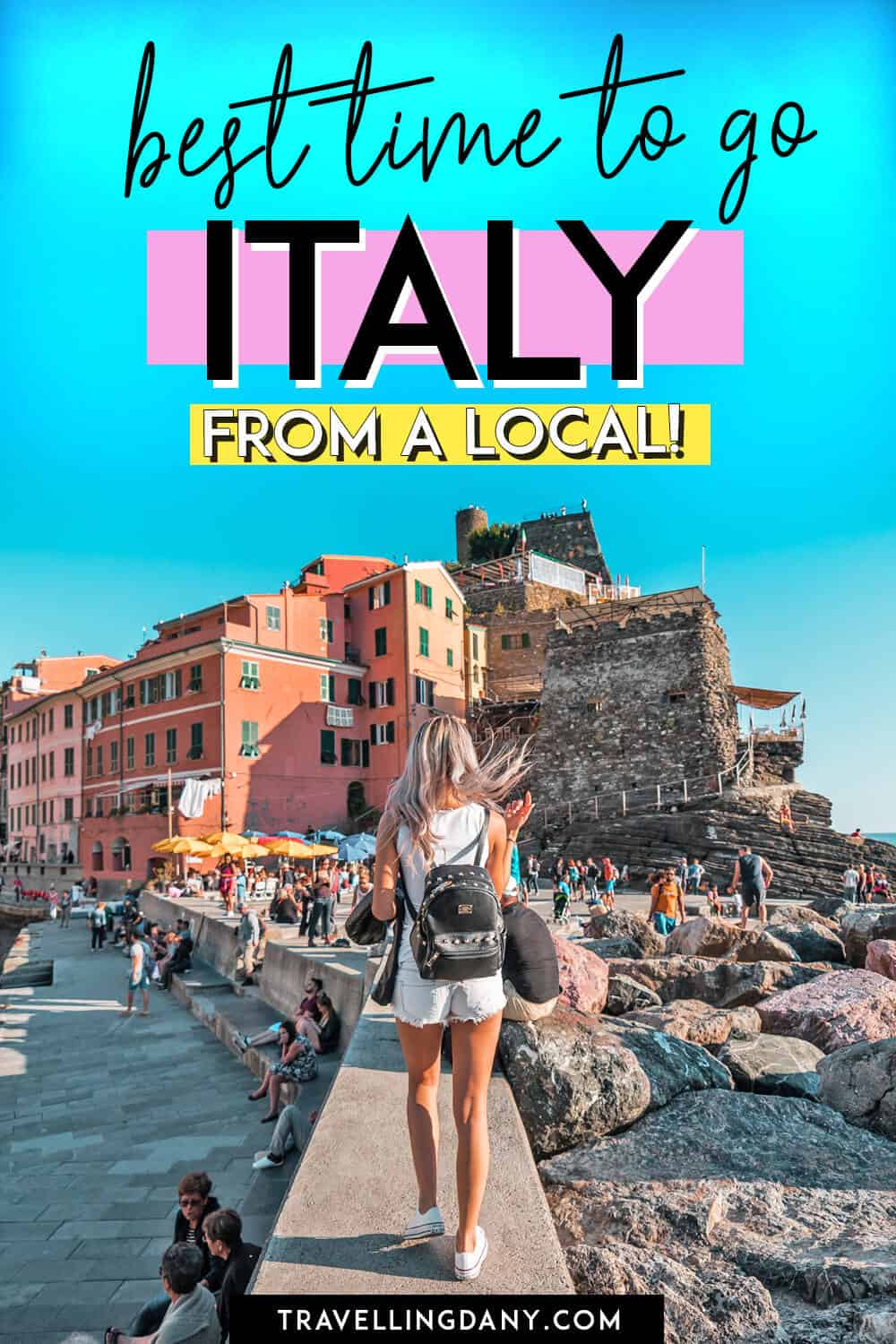
Travelling Dany – Danila Caputo
Danila Caputo is a bilingual travel writer living in between Naples and the Amalfi Coast (Italy), graduating from the University of Naples Suor Orsola Benincasa in Foreign Languages and Literature. She travels and works with her husband Aldo, photographer and videographer. Their blog chronicles their adventures around the world, their love for the USA (where they have family), Italian/European culture and tips on how to be responsible travelers. You can find out more about their latest trips and their life on Youtube, Instagram and Facebook.

